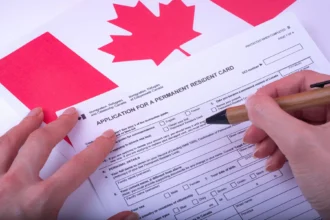Canada is a top destination for international students, known for its high-quality education, diverse culture, and welcoming environment. If you’re considering pursuing your education in Canada, obtaining a study permit is a crucial step. This guide will walk you through the entire process of applying for a Canadian study permit, from choosing the right institution to arriving in Canada, ensuring that you have all the information you need to navigate the process successfully.
Understanding the Canadian Study Permit
A Canadian study permit is a document issued by Immigration, Refugees, and Citizenship Canada (IRCC) that allows foreign nationals to study at designated learning institutions (DLIs) in Canada. While a study permit grants you the ability to study in Canada, it is not a visa. Depending on your country of origin, you may also need a visitor visa or an electronic travel authorization (eTA) to enter Canada. The study permit is essential for any international student planning to study in Canada for more than six months, and it must be obtained before you arrive in the country.
Step 1: Choosing the Right Designated Learning Institution (DLI)
Before you can apply for a study permit, you must first be accepted by a Designated Learning Institution (DLI) in Canada. A DLI is a school approved by the provincial or territorial government to host international students. Choosing the right DLI is a critical decision that will impact your entire study experience in Canada.
Factors to Consider When Choosing a DLI
- Program Offerings: Ensure the DLI offers the program you are interested in. Research the curriculum, faculty, and available resources to determine if the program aligns with your academic and career goals.
- Accreditation and Reputation: It’s essential to choose a DLI that is accredited and has a good reputation. Look for institutions with strong academic programs and positive reviews from current and former students.
- Location: The location of the DLI can significantly impact your experience in Canada. Consider factors such as the cost of living, climate, and proximity to urban centers. Provinces like Ontario, British Columbia, and Quebec are popular choices, but each region offers unique opportunities and challenges.
- Post-Graduation Opportunities: Some DLIs offer programs that qualify you for a Post-Graduation Work Permit (PGWP), allowing you to stay and work in Canada after completing your studies. Research which institutions and programs offer this option, as it can be a critical factor in your decision.
- Support Services: Look for DLIs that offer robust support services for international students, including academic advising, career counseling, housing assistance, and mental health resources.
- Cost and Financial Aid: Evaluate the tuition fees and living expenses associated with studying at different DLIs. Some institutions may offer scholarships, grants, or financial aid to international students, which can help offset the costs.
Once you’ve chosen a DLI and program, you must apply directly to the institution. Upon acceptance, you will receive a letter of acceptance, which is a mandatory document for your study permit application.
Step 2: Preparing the Required Documents
Gathering the necessary documents is a crucial step in the study permit application process. The specific documents required can vary depending on your country of origin, but generally include:
1. Letter of Acceptance
- This document is issued by your chosen Designated Learning Institution (DLI) and must include details such as the program of study, tuition fees, and the start and end dates of the program.
2. Valid Passport or Travel Document
- Ensure your passport is valid for the duration of your stay in Canada. If your passport expires during your studies, you’ll need to renew it and reapply for a study permit with the new passport.
3. Proof of Financial Support
- You must demonstrate that you have sufficient funds to cover tuition fees, living expenses, and return transportation. This can include:
- Bank statements showing sufficient funds in your account.
- Proof of a student loan from a financial institution.
- Scholarship or financial aid letters from the DLI or external organizations.
- A letter from a sponsor or financial supporter, along with their financial documents.
4. Passport-Sized Photos
- Two recent passport-sized photos are required. Ensure the photos meet the specifications provided by IRCC, including size, background, and quality requirements.
5. Statement of Purpose (SOP)
- The Statement of Purpose is a letter explaining your motivation for studying in Canada, your educational goals, and how your chosen program will help you achieve those goals. This document should clearly articulate your reasons for choosing Canada as your study destination and demonstrate your commitment to returning to your home country after your studies.
6. Immigration Medical Examination (IME)
- Depending on your country of residence, you may need to undergo a medical examination by a panel physician approved by IRCC. This examination ensures that you do not have any medical conditions that would make you inadmissible to Canada.
7. Police Certificates
- A police certificate may be required to prove that you have no criminal record. This document is essential to demonstrate your admissibility to Canada.
8. Proof of Payment
- You will need to provide a receipt showing that you have paid the study permit application fee. This fee is typically CAD $150, but it may vary depending on additional requirements such as biometrics.
It’s essential to gather these documents well in advance to avoid any delays in your application process. All documents must be accurate, complete, and up to date. Incomplete or incorrect documentation can result in delays or even the refusal of your application.
Step 3: Applying for a Study Permit
Once you have gathered all the required documents, you can proceed to apply for your study permit. There are two main ways to apply: online or on paper. Applying online is generally faster and more convenient, but both methods are available depending on your preference.
Applying Online
- Create an IRCC Account: Visit the IRCC website and create an online account. This account will allow you to manage your application, upload documents, and receive updates on the status of your application.
- Complete the Application Form: Fill out the Study Permit Application form (IMM 1294) accurately. Make sure all the information matches the details in your supporting documents to avoid any discrepancies.
- Upload Supporting Documents: Upload all the required documents, including your letter of acceptance, passport, proof of financial support, and any other relevant documents.
- Pay the Application Fee: The standard application fee for a study permit is CAD $150. You may also need to pay an additional fee for biometrics (CAD $85). Payment is typically made online through the IRCC portal.
- Submit Biometrics: Depending on your nationality, you may be required to provide biometrics (fingerprints and a photo) at a Visa Application Centre (VAC). Biometrics help IRCC verify your identity and process your application more efficiently.
- Submit Your Application: After completing all the steps, submit your application online. You will receive a confirmation of submission and a reference number to track your application.
Applying on Paper
If you prefer to apply on paper, you can download the necessary forms from the IRCC website, fill them out, and mail them along with your supporting documents to the appropriate visa office. Keep in mind that paper applications generally take longer to process than online applications.
Step 4: Processing and Waiting Period
After submitting your study permit application, you must wait for IRCC to process it. Processing times vary depending on your country of origin and the time of year. It’s important to be patient and regularly check the status of your application.
Tips for Monitoring Your Application
- Check Your IRCC Account Regularly: If you applied online, log in to your IRCC account frequently to check the status of your application. IRCC may request additional information or documents during the processing period, so it’s essential to stay updated.
- Prepare for a Possible Interview: In some cases, IRCC may require you to attend an interview at your local Canadian visa office. Be prepared to answer questions about your study plans, financial support, and intentions after completing your studies.
- Respond Promptly to Requests: If IRCC requests additional documents or information, respond as quickly as possible to avoid delays. Delays in providing requested information can result in extended processing times or even refusal of your application.
- Check Processing Times: You can check the estimated processing times for study permits on the IRCC website. Keep in mind that these times are estimates and can vary based on several factors, including application volume and your specific circumstances.
Step 5: Receiving a Decision on Your Application
Once IRCC has processed your application, you will receive a decision. If your study permit application is approved, you will receive:
- Port of Entry (POE) Letter of Introduction: This letter confirms that you have been approved for a study permit. It is not the study permit itself but must be presented to the border services officer when you arrive in Canada.
- Temporary Resident Visa (TRV) or Electronic Travel Authorization (eTA): Depending on your nationality, you may need a TRV or eTA to enter Canada. This document will be issued along with your study permit approval.
If your application is refused, IRCC will provide reasons for the refusal, and you may have the option to reapply or appeal the decision, depending on the circumstances.
Common Reasons for Study Permit Refusal
Understanding the common reasons for study permit refusals can help you avoid potential pitfalls:
- Insufficient Proof of Financial Support: If IRCC determines that you do not have enough funds to cover your tuition, living expenses, and return transportation, your application may be refused.
- Incomplete or Inaccurate Documentation: Providing incomplete or incorrect information in your application can lead to refusal. Ensure that all documents are accurate and match the information provided in your application.
- Lack of Strong Ties to Your Home Country: IRCC may refuse your application if they believe you do not have sufficient ties to your home country, such as family, employment, or property, which would compel you to return after your studies.
- Poor Academic Performance: If your academic history does not align with the program you intend to study, IRCC may question your intentions and refuse your application.
If your study permit application is refused, carefully review the reasons provided by IRCC, address the issues, and consider reapplying with a stronger application.
Step 6: Preparing for Your Arrival in Canada
With your Port of Entry (POE) Letter of Introduction, temporary resident visa (TRV), or electronic travel authorization (eTA), you are now ready to travel to Canada. Preparing for your arrival is crucial to ensure a smooth transition.
Tips for a Smooth Arrival
- Organize Your Documents: Upon arrival in Canada, you must present several documents to the border services officer, including:
- Your passport and TRV or eTA.
- Port of Entry (POE) Letter of Introduction.
- Letter of acceptance from your DLI.
- Proof of financial support.
- Any other documents recommended by IRCC, such as medical or police certificates.
- Prepare for Border Services Questions: The border services officer may ask you questions about your study plans, your intended length of stay, and how you plan to support yourself in Canada. Answer all questions clearly and honestly.
- Receive Your Study Permit: If all your documents are in order and the border services officer is satisfied with your responses, they will issue your study permit. This document outlines the conditions of your stay, including your study program, DLI, and any work authorization if applicable.
- Understand the Conditions of Your Study Permit: Your study permit may include specific conditions, such as the requirement to remain enrolled in a full-time program, the ability to work part-time, and maintaining good academic standing. It’s important to understand and comply with these conditions to avoid any issues during your stay.
Step 7: Beginning Your Studies in Canada
With your study permit in hand, you can now begin your studies at your chosen DLI in Canada. This is an exciting time, but it’s important to stay focused on your academic and personal goals.
Adjusting to Life in Canada
- Orientation and Support Services: Many DLIs offer orientation programs for international students. These programs can help you get acquainted with the campus, meet fellow students, and learn about the resources available to you.
- Health Insurance: Health insurance is mandatory for international students in most provinces. Check with your DLI or the provincial health authority to ensure you have adequate coverage during your stay.
- Housing and Transportation: Secure your accommodation before arriving in Canada and familiarize yourself with the local transportation options. Whether you choose on-campus housing or an off-campus apartment, make sure it meets your needs and budget.
- Cultural Adjustment: Canada is a multicultural society, and adjusting to life here may take some time. Engage with your peers, join student organizations, and participate in campus events to build a support network and enrich your experience.
Step 8: Working While Studying in Canada
One of the benefits of studying in Canada is the ability to work while you study. With a valid study permit, you may be eligible to work on or off-campus without a separate work permit.
Working On-Campus
- Eligibility: You can work on-campus if you are enrolled full-time at a DLI and have a valid study permit.
- Job Opportunities: On-campus jobs may include roles in libraries, administrative offices, or campus cafes. Check with your DLI’s career services for available positions.
Working Off-Campus
- Eligibility: You can work off-campus if you are enrolled full-time in a program at a DLI that leads to a degree, diploma, or certificate, and your study permit includes a condition allowing you to work off-campus.
- Work Hours: You are allowed to work up to 20 hours per week during regular academic sessions and full-time during scheduled breaks, such as winter or summer holidays.
Co-op and Internship Programs
Some academic programs in Canada include co-op or internship components that require work experience as part of the curriculum. If your program includes such a component, you may need to apply for a co-op work permit in addition to your study permit.
Step 9: Extending Your Stay in Canada
If your program of study extends beyond the expiry date of your study permit, or if you wish to pursue further studies in Canada, you will need to apply for an extension before your current permit expires.
How to Extend Your Study Permit
- Apply Before Expiry: Submit your application to extend your study permit at least 30 days before your current permit expires. Applying early ensures that you maintain your legal status in Canada while your new permit is processed.
- Required Documents: The extension application typically requires an updated letter of acceptance from your DLI, proof of continued financial support, and a valid passport.
- Online Application: You can apply for a study permit extension online through your IRCC account. Ensure that all information and supporting documents are accurate and complete.
Step 10: Pathways to Permanent Residency
Studying in Canada can also open doors to permanent residency. Many international students choose to stay in Canada after their studies by applying for permanent residency through various immigration pathways.
Post-Graduation Work Permit (PGWP)
- Eligibility: Graduates from eligible DLIs can apply for a Post-Graduation Work Permit (PGWP), allowing them to work in Canada for up to three years after completing their studies. The length of the PGWP depends on the duration of your study program.
- Application Process: Apply for the PGWP within 180 days of receiving your final marks or graduation certificate. The application can be submitted online, and you must hold a valid study permit when you apply.
Express Entry System
- Canadian Experience Class (CEC): The Canadian Experience Class (CEC) under the Express Entry system is designed for individuals with Canadian work experience. If you have gained skilled work experience through the PGWP, you may be eligible to apply for permanent residency through the CEC.
- Provincial Nominee Program (PNP): Many provinces have immigration streams under the Provincial Nominee Program (PNP) that are tailored for international graduates. These streams can provide a pathway to permanent residency for students who have studied and gained work experience in a specific province.
Conclusion
Applying for a Canadian study permit is a detailed and multi-step process that requires careful planning and preparation. From choosing the right Designated Learning Institution (DLI) to preparing your application and arriving in Canada, each step is crucial to ensuring a successful study experience in Canada.
By following the comprehensive steps outlined in this guide, you can navigate the study permit application process with confidence. Remember to stay informed, gather all necessary documents, and adhere to deadlines to increase your chances of success.
For more detailed information and to begin your application, visit the Government of Canada’s official immigration page. Studying in Canada offers a wealth of opportunities for academic and personal growth, and with the right preparation, you can embark on a rewarding educational journey in one of the world’s most welcoming countries.



